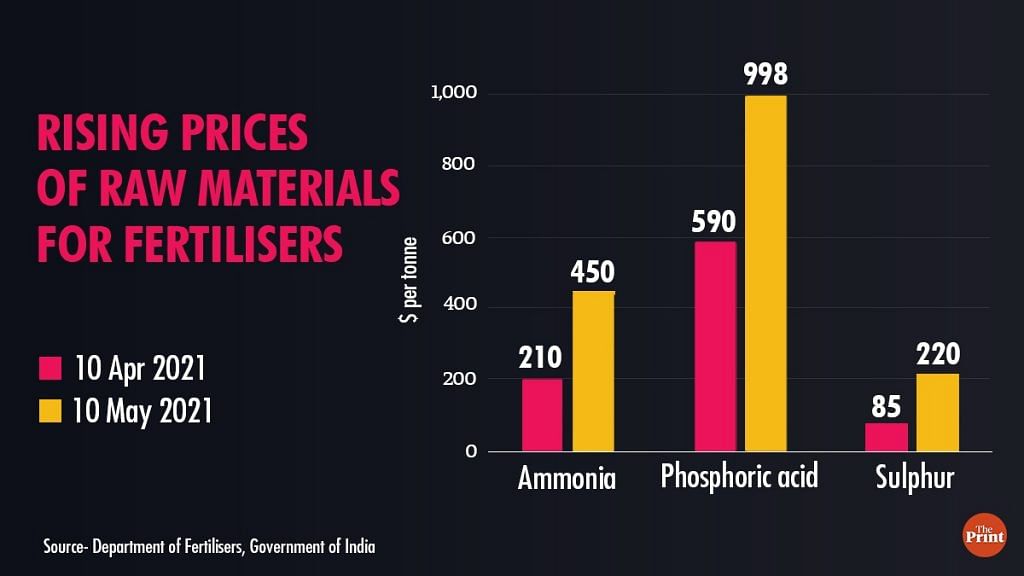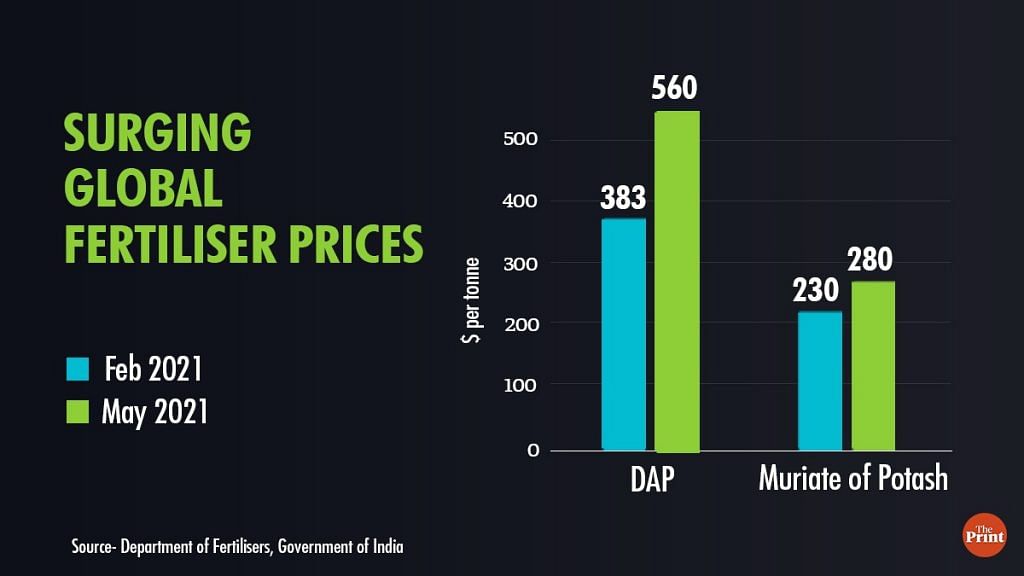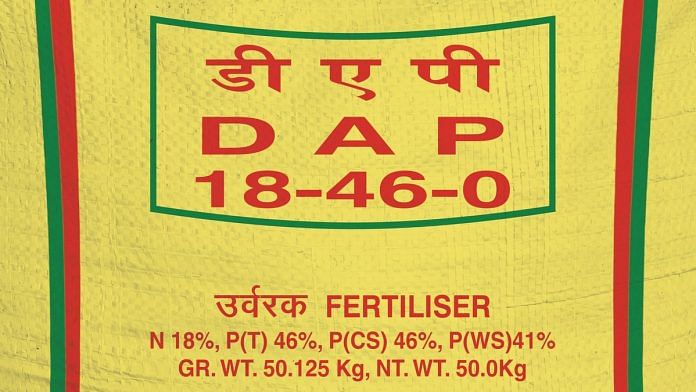New Delhi: Last Wednesday, the Union government increased the amount of subsidy it provides for di-ammonium phosphate (DAP) fertilisers to protect farmers from its surging prices due to the increasing cost of raw materials globally.
The Department of Fertilisers, in its 19 May notification, has increased the subsidy on DAP to Rs 1,200 per 50 kg bag (or Rs 24,000 per tonne), a 140 per cent increase from the earlier Rs 500 per bag (or Rs 10,000 per tonne).
Before this notification, the Indian Farmers Fertiliser Cooperative (IFFCO), the country’s largest fertiliser seller, had increased the prices of a 50 kg bag of DAP by 58 per cent to Rs 1,900 from Rs 1,200 (inclusive of the subsidy). Other companies’ DAP prices also increased by 46-60 per cent. But now, the government has ensured the price of DAP for the farmer will remain the same — Rs 1,200 per bag.
DAP is the second most popular fertiliser among Indian farmers behind urea — in 2020-21, 119.13 lakh tonnes of DAP were purchased, compared to 350 LT for the top-selling urea. Thus, a rise in its price would’ve had a severe impact on Indian farmers — for example, growing soybean on an acre of land would’ve cost Rs 1,900 more if the subsidy wasn’t increased.
Overall, the government increased its fertiliser subsidy outlay for 2021-22 to Rs 94,305 crore from the budgetary outlay of Rs 79,530 crore. In 2020-21 too, the Centre had increased the fertiliser subsidy outlay to Rs 1.34 lakh crore from Rs 71,309 crore, a jump of nearly 88 per cent.
Also read: Dal farmers & traders fear big losses, dip in production after Modi govt allows free imports
Rising global prices
DAP contains 46 per cent phosphate and 18 per cent nitrogen, and is often used alongside other fertilisers with the same nutrients, urea and muriate of potash (MOP). Internationally, the cost of the raw materials used to make DAP, as well as the cost of the finished product, has risen manifold.

According to figures from the Department of Fertilisers, Government of India, global prices of phosphoric acid and ammonia, which are key components in making DAP, rose by 60-70 per cent between 10 April and 10 May. While ammonia prices surged to $450 per metric tonne from $210/MT, those of phosphoric acid increased to $998/MT from $590/MT. The prices of sulphur, another ingredient of DAP, jumped to $220/MT from $85/MT.
As a result, the price of imported DAP rose to $560/tonne (approximately Rs 40,000/tonne) on 10 May, from $383/tonne (Rs 27,000/tonne) on 10 February. The price of MOP fertilisers also increased to $280/MT from 230$/MT.

Ashish Agrawal, senior analyst at India Ratings and Research, told ThePrint: “Potash and phosphoric acid have only a few big players and very few mines in the world, which control production and prices. Raw material demand has also increased this year, with better agricultural production sentiment.”
Agrawal added: “Potash and rock phosphate are almost non-available in India, and almost every non-urea fertiliser input is imported. Such high DAP prices of $500-550 per tonne were last seen in 2012-13, while ammonia had hit $450 per tonne in 2015.”
At these increased prices, by the time imported DAP would arrive at Indian ports, it would cost Rs 45,950/tonne. Accounting for the government subsidy of Rs 10,000 per tonne and 5.5 per cent GST, the cost-to-company at a no-profit-no-loss basis would to Rs 37,500/tonne, rather than the existing Rs 24,000/tonne.
Agrawal explained: “Though (Indian) players held off an increase in prices of fertilisers for a while to not dent demand in the upcoming kharif season, a further surge in product demand and increase in input price forced them to hike the finished product’s price.”
But now, the government has increased the subsidy on phosphorus to Rs 45.3/kg from Rs 14.8/kg, while keeping the subsidy on three other crucial ingredients of fertilisers — nitrogen, potash and sulphur — constant. This means that firms will now be able to sell DAP at the same price as before, but the other fertilisers such as NPK and MOP will continue to see increased prices.
Why govt had to act
The government provides fertilisers such as urea and DAP to farmers at subsidised prices via manufacturers and importers. While urea subsidy varies from time to time, in order to keep its selling price constant amid market fluctuations, non-urea fertiliser subsidy such as that for DAP, NPK and MOP fertilisers, is given on a per-tonne basis to companies, which means final prices can vary.
This was the situation emerging before the government, companies and farmers due to the rising global prices. As the government subsidy on DAP remained unchanged from levels announced in April 2020, firms had to increase their fertiliser prices.
With the price of urea remaining unchanged at Rs 268/bag since 2012, the DAP price hike could have resulted in farmers increasing urea usage, affecting soil health.
In addition, the rising costs would have resulted in the government having to increase crops’ minimum support prices, thus spiking food inflation.
(Edited by Shreyas Sharma)
Also read: Consumer demand drop in lockdown could cut palm oil prices, Vanaspati & soap costs may fall



